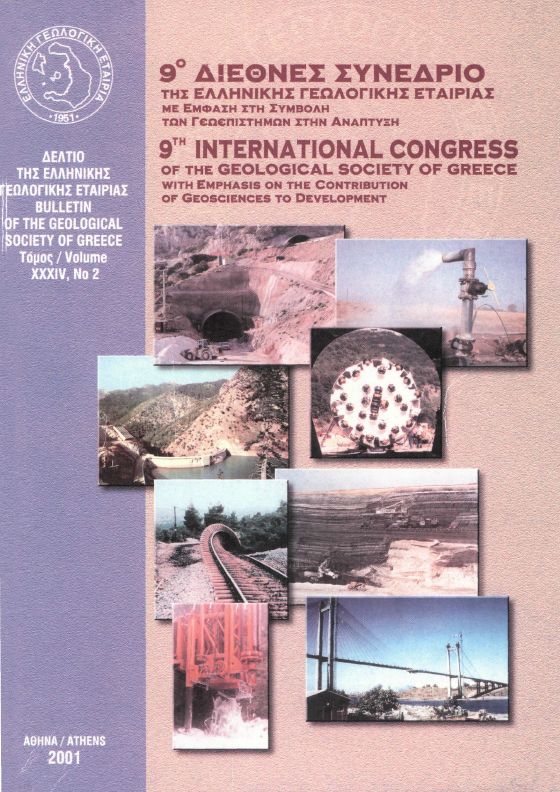New data on the Dogger - Cenomanian stratigraphy of Tripolitza series in Central Crete

Abstract
Tripolitza series represents the eastern part of the Gavrovo - Tripolitza platform. It outcrops in central and southeastern Peloponnesus, Crete and the Aegean islands. Its stratigraphie column starts with a volcano-sedimentary, clastic sequences (the Tyros beds), of Late Paleozoic to Late Triassic age, followed by a carbonate series of Late Triassic to Late Eocene age and a tertiary flysch. On account of intense dolomitisation as well as of rarity of fossils, the stratigraphy of Tripolitza series is not so well known as the Gavrovo series. Recent investigation attempts to complete the puzzle of Tripolitza's stratigraphie column and to reconstruct the paleogeographic sedimentation conditions. In this paper, we study some stratigraphie sections, which are taken in different places in northern – central Crete(Fig.l). New data about the stratigraphy and the sedimentation conditions of the Tripolitza series during Late Dogger to Cenomanian, complete older ones and provide information about the paleogeographic evolution of the platform. Late Dogger is determinated by Pfenderina salernitana. It is overlain by a carbonate series containing Cladocoropsis mirabilis and Macroporella sellii, dating Early Malm. Early Malm (Oxfordian - Early Kimmeridgian) is characterized by the presence of Cladocoropsis mirabilis, Kurnubia palastiniensis, Neokilianina rahonensis, Parurgonina caelinensis. Late Malm (Late Kimmeridgian - Portlandian) is characterized by Clypeina jurassica and Kurnubia palastiniensis. Early Cretaceous (Valanginian - Barremian) is determinated by Salpingoporella katzeri and Orbitolinopsis capuensis. Early Aptian is determinated by Palorbitolina lenticularis, Salpingoporella dinarica, Debarina hahounerensis, Pseudocyclammina hedbergi. Late(?) Aptian comprises Sabaudia minuta, Cuneolina hensoni, Cuneolina laurentii, Glomospira urgoniana. Albian is characterized by the disappearence of Cuneolina hensoni and Cuneolina laurentii, while Praechrysalidina infracretacea and Cretacicladus minervini are present. Late Albian is determined by the presence of "Coskinolina" bronnimanni. Early Cenomanian is not determinated by characteristic microfossils. Upper Cenomanian is overlain in comformity with upper Albian - lower Cenomanian carbonates. It is characterized by Chrysalidina gradata, Pseudorhapydionina dubia, Pseudorhapydionina laurinensis, Nummoloculina heimi, Broeckina balcanica, Nezzazata gyra, Biconcava bentori, Trochospira anvimelechi. Sedimentation took place in a peritidal environment. We observe alternations of subtidal and intratidal to supratidal conditions of sedimentation. Comparison between the carbonate microfacies of different sections representing synchronous deposits on different places of the platform, show lateral differentiation of depositional environments, from subtidal to supratidal, even supported short and local emersive episodes, (compare lower Aptian deposits of Profitis Ilias and Pinakianou sections, upper Albian deposits of Kythia and Karouzanos sections in present paper, as well as upper Cenomanian deposits of Karouzanos section in this paper, Louloudaki section (ZAMBETAKIS-LEKKAS et al. 1995 and Vitina section ZAMBETAKIS et al. 1988, Varassova section BERNIER & FLEURY 1980, Gavrovo mountain I.G.R.S. & I.F.P. 1966)(Fig.2). Similar sedimentation characterize the perimediterranean platforms during this period (SARTONI & CRESCENTI 1962, DE CASTRO 1962, FARINACCI & RADOICIC 1964, GUSIC 1969, GUSIC, NIKLER & SOKAC 1971, VELIC 1977, CHIOCCHINI et. al.1979, LUPERTO SINNI & MASSE 1993).
Article Details
- How to Cite
-
ΖΑΜΠΕΤΑΚΗ - ΛΕΚΚΑ Α., & ΑΛΕΞΟΠΟΥΛΟΣ Α. (2018). New data on the Dogger - Cenomanian stratigraphy of Tripolitza series in Central Crete. Bulletin of the Geological Society of Greece, 34(2), 565–575. https://doi.org/10.12681/bgsg.17096
- Section
- Stratigraphy

This work is licensed under a Creative Commons Attribution-NonCommercial 4.0 International License.
Authors who publish with this journal agree to the following terms:
Authors retain copyright and grant the journal right of first publication with the work simultaneously licensed under a Creative Commons Attribution Non-Commercial License that allows others to share the work with an acknowledgement of the work's authorship and initial publication in this journal.
Authors are able to enter into separate, additional contractual arrangements for the non-exclusive distribution of the journal's published version of the work (e.g. post it to an institutional repository or publish it in a book), with an acknowledgement of its initial publication in this journal. Authors are permitted and encouraged to post their work online (preferably in institutional repositories or on their website) prior to and during the submission process, as it can lead to productive exchanges, as well as earlier and greater citation of published work.



